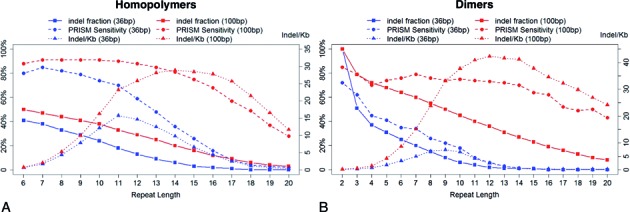Figure 6.

Quantification of indel detection by PRISM in homopolymers (A) and dimers (B). ‘36 bp’ and ‘100 bp’ stand for 36 bp and 100 bp read sets respectively. (A) The PRISM detection sensitivity is defined using the reference set from (Kidd et al. 2008). The indel density is the number of detected indels per 1 Kbp of the homopolymer region. The residual indel fraction for a given length is the proportion of the detected indels in homopolymers of the same length or longer (i.e. the reverse of the cumulative distribution function). As the length of homopolymers grows, the indel density keeps growing at first, suggesting that more indels exist in longer homopolymers. After a peak the indel densities start to decrease along with the PRISM sensitivity, suggesting that the density is affected by the difficulty of detecting indels in longer homopolymers. (B) Similar metrics were computed for indels detected in dimer regions, and similar patterns were observed.
